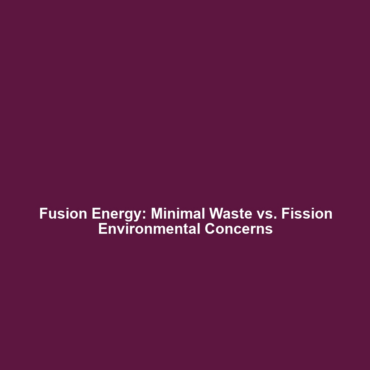The Promise of Fusion Energy: Minimal Long-Lived Radioactive Waste
Introduction
Unlike nuclear fission, which splits heavy atomic nuclei and creates significant long-lived radioactive waste, fusion energy offers a cleaner alternative that addresses many environmental concerns associated with fission reactors. Fusion processes, which involve the merging of light atomic nuclei to form heavier ones, promise a nearly limitless energy supply with a vastly reduced environmental footprint. This shift towards fusion energy is critical as we seek sustainable and ecologically responsible energy solutions in our fight against climate change.
Key Concepts
To understand the significance of fusion energy and its advantages over nuclear fission, it is essential to grasp the key concepts that underpin fusion processes.
1. Fusion Process
The fundamental principle of nuclear fusion involves the combination of light isotopes, typically isotopes of hydrogen, like deuterium and tritium, at extremely high temperatures and pressures. This process releases energy far more efficiently than fission.
2. Radioactive Waste Management
One of the major environmental advantages of fusion energy is its minimal production of long-lived radioactive waste. In contrast to fission reactors, which generate highly radioactive isotopes that require secure long-term storage, the waste from fusion processes is primarily short-lived and can decay to safe levels within a few years.
Applications and Real-World Uses
The implications of fusion energy extend beyond theoretical research and into practical applications, suggesting a transformative future for energy production.
How Fusion Energy is Used in Power Generation
- Electric Power Generation: Fusion reactors have the potential to provide large scales of electricity without the harmful byproducts of fission.
- Space Exploration: Fusion energy could be harnessed for propulsion in long-term space missions, reducing travel time to distant planets.
- Hydrogen Production: The fusion process could be adapted to produce hydrogen, a key component in sustainable energy systems.
Current Challenges
Despite its potential, fusion energy faces several challenges that hinder its widespread adoption.
- Technological Complexity: Achieving and sustaining the extreme conditions required for fusion is technologically daunting.
- Cost and Investment: The initial investment required for fusion research and development is significantly high.
- Public Perception: There is a lack of public understanding and acceptance of fusion technology compared to established fission reactors.
Future Research and Innovations
Research into fusion energy is ongoing, with numerous innovations on the horizon that could revolutionize energy production.
- ITER Project: The International Thermonuclear Experimental Reactor (ITER) aims to demonstrate the feasibility of fusion as a large-scale energy source.
- Private Sector Investments: Start-ups and private companies are exploring new fusion technologies that may accelerate the development timeline.
- Advanced Materials: Innovations in materials science are necessary to withstand the extreme conditions within fusion reactors.
Conclusion
In conclusion, the promise of fusion energy lies in its ability to produce minimal long-lived radioactive waste while addressing many of the environmental issues associated with nuclear fission. As research advances and we overcome existing challenges, fusion energy could become a cornerstone of sustainable energy production. To learn more about fusion energy and its applications, visit our other articles on [Energy Innovations](#) or [Sustainable Energy Solutions](#).








